
ENGLISH
DESCRIPTION
The unit can be found in filtering hoods or in exhaust hoods. In the Filtering hoods (Fig. 1) the air and steam taken
up by the unit are purified with charcoal filters and returned to the environment through the aeration grids on the side
of the flue. WARNING: When using filtering hoods, both charcoal filters and an air deflector must be used. Located
in the upper part of the flue, this deflector recycles the air to the environment (Fig. 1A). The charcoal filters are not
supplied. In the Exhaust hoods (Fig .2) an exhaust duct conveys the steam and cooking odors directly outside
through the wall/ceiling. Therefore they do not require charcoal filters.
INSTALLATION
To facilitate installation, before starting remove the grease filter/s: press inward on the clamp at the handle and pull
the filter downward (Fig. 3/4).
Installation of a utensil holder (upon request): see Figure 5A or 5B depending on the model purchased. Install the
utensil holder with 4 flathead screws (supplied). Secure the 2 supports (C) to the hood, one on the left and one on
the right; insert the utensil holder into these supports. Keep a good grip on it until you have installed, and secured,
at least one of the 2 supports (D) at the top of the hood.
Installation on the wall (Fig. 6): using the special drilling template, drill the required holes in the wall. As previously
specified in the chapter “Warning” remember there must be a minimum of 650 mm between the bottom edge of the
hood and the stop of the stove. Secure the metal bracket (B) to the wall using the screws and plugs (bracket, screws
and plugs are all supplied with the unit). Use the 2 triangles cut into the bracket to position it precisely along the
vertical axis of the hood. Then set the hood onto the bracket. Adjust the horizontal position, shifting the hood to the
right or left as needed lining it up with the wall units. If the height of the hood also requires adjustment, use the special
regulation screws (V) (supplied). Once regulation has been completed, finish securing the hood with 4 more screws
(M): mark the points for the 4 holes on the wall, remove the hood and drill (8mm diameter holes); then use the plugs
and screws to complete installation.
Installation with rear panel (Fig. 7): the rear panel is positioned at the top of the stove, flush against the wall. Rest
the lower edge of the panel behind the stove and anchor the upper edge to the wall using the two holes found on
the panel. Insert the screws and plugs provided (A). The unit is secured to the rear panel as though it were being
installed on the wall: use the supplied metal bracket (B) and the screws and plugs supplied with the panel.
Securing the extension flues: basic installation requirements: – Set the electrical power supply within the space
covered by the decorative flues. – If your unit is installed in an Exhaust hood, prepare the air exhaust hole.
Adjust the width of the extension flue support bracket (W) using screws A indicated in Fig. 8. Then use the plugs
and screws provided to secure it to the ceiling. Make certain it is aligned with the hood. For filtering hoods, the air
exhaust grids are positioned in the upper part (Fig. 9). For exhaust hoods, turn the upper flue over so that the air
exhaust grid is in the lower section (Fig. 10).
Be very careful when handling the telescopic pipes, especially when resting these on the hood body, to
prevent scratching.
Exhaust hoods : connect the disposal duct to the air evacuation pipe of the hood. Use a flexible pipe and lock it to
the air evacuation pipe of the hood with a metal hose clamp (pipe and clamp are not provided).
Plug in the hood. Insert the telescopic flues setting them on the hood; extend the upper flue to the ceiling and secure
with the 2 screws (G) - Fig. 11.
Filtering hood: Take the air deflector and fit a flexible pipe to it (125 mm diameter) locking it with a metal hose clamp
(pipe and clamps are not provided). Fit the air deflector to the upper flue (Fig. 12) with 4 screws. Install the reduction
(provided) on the hood air outlet point (Fig. 13). Take the 2 assembled extension flues and set them on the hood;
extend the upper flue to the ceiling and secure with the 2 screws (G) - Fig. 11. Extend the lower flue taping it in place
and then connect the flexible pipe to the hood reduction. Plug in the hood. Extend the lower flue downward setting
it against the hood. Install the charcoal filters on the side of the motor inserting them with a twisting movement
(Fig.14).
OPERATION
Depending on the model, the unit is equipped with the following controls:
Controls shown in Fig. 15:
Button A = turns the lights on/off. Button B = turns the TIMER on/off: press once
to turn the timer on, therefore, after 5 minutes, the motor cuts out (at the same time the selected speed blinks on
the display); the timer remains on if the motor speed is changed.
Display C = - indicates the selected motor speed
(from 1 to 4); - indicates Timer On when the number blinks; - indicates Filter Alarm when the central segments is
on or blinking.
Button D = makes the motor work (at the last speed selected); pushing the button again, the speeds of the motor
are sequentially selected from 1 to 4; keeping this button pressed for about 2 seconds shuts down the motor.
Button R = resets the grease filters or charcoal filters; when the filter alarm appears (i.e. when the central segment
on the display goes on), the grease filters must be cleaned (30 hours of operation); when the central segment starts
blinking, the grease filters must be cleaned and the charcoal filters replaced (120 hours of operation). Obviously,
if the hood is not a filtering model and does not have a charcoal filter, clean the grease filters both when the central


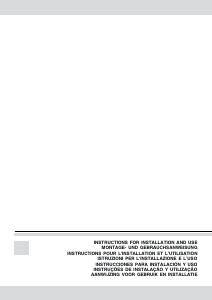

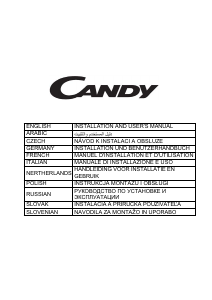
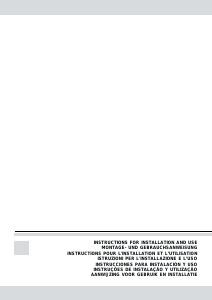
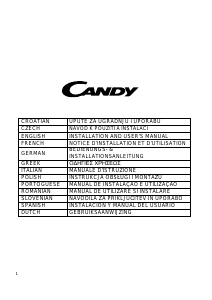
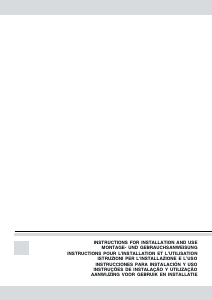
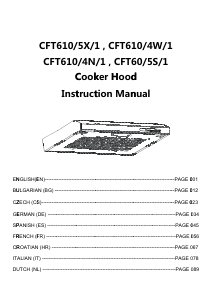
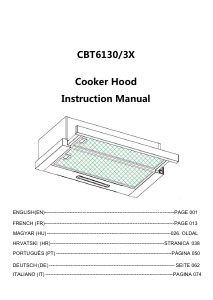

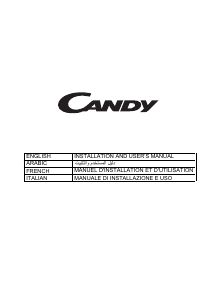
Partecipa alla conversazione su questo prodotto
Qui puoi condividere cosa pensi di Candy CMD 93 X Cappa da cucina. Se hai una domanda, leggi prima attentamente il manuale. La richiesta di un manuale può essere effettuata utilizzando il nostro modulo di contatto.